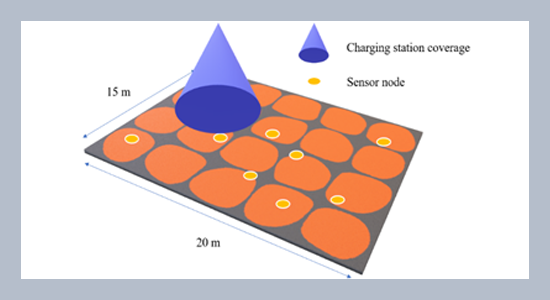Shiang-Yu Hu1, Yu-Cheng Tsai2, Shang-Juh Kao1, Fu-Min Chang3* 1 Department of Computer Science and Engineering, National Chung-Hsing University, 145, Xingda Rd., South District., Taichung City, 402, Taiwan 2 Ph.D. Program of Business Administration in Industrial Development, Chaoyang University of Technology, 168, Jifeng E. Rd., Wufeng District, Taichung City 413310, Taiwan 3 Department of Finance, Chaoyang University of Technology, 168, Jifeng E. Rd., Wufeng District, Taichung City, 41349, Taiwan
Download Citation:
|
Download PDF
In wireless rechargeable sensor networks (WRSNs), wireless charging stations can recharge the batteries of sensor nodes so that they can operate sustainably. Since wireless charging stations are costly and have limited charging distances, how to deploy the minimal number of charging stations to cover all sensor nodes and satisfy the energy requirements of all sensor nodes are important and challenging issues. This paper proposes a new deploy strategy by taking the number of charging stations and the distance between the sensor node and charging station into account simultaneously. We formulate the proposed strategy into a multi-objective problem and employ a non-dominated sorting genetic algorithm-II (NSGA-II) to solve this problem. We compare the proposed approach to the simulated annealing-based charging algorithm (SABC) and the layoff simulated annealing-based charging algorithm (LSABC) in terms of the number of charging stations and the overall charging power. The simulation results reveal that the overall charging power obtained using the proposed approach is 5% and 8% higher than that obtained using SABC and LSABC approaches. Moreover, the number of charging stations obtained using NSGA-II is 6% and 1% less than that obtained using SABC and LSABC approaches, respectively.ABSTRACT
Keywords:
Wireless rechargeable sensor networks, Wireless charging stations deployment, NSGA-II, Multi-objective problem.
Share this article with your colleagues
REFERENCES
ARTICLE INFORMATION
Received:
2021-08-26
Revised:
2022-01-24
Accepted:
2022-03-06
Available Online:
2022-05-30
Hu, S.-T., Tsai, Y.-C., Kao, S.-J., Chang, F.-M., Using non-dominated sorting genetic algorithm-ii for charging station deployment in wireless rechargeable sensor networks. International Journal of Applied Science and Engineering, 19, 2021352. https://doi.org/10.6703/IJASE.202206_19(2).002
Cite this article:
Copyright The Author(s). This is an open access article distributed under the terms of the Creative Commons Attribution License (CC BY 4.0), which permits unrestricted use, distribution, and reproduction in any medium, provided the original author and source are cited.






